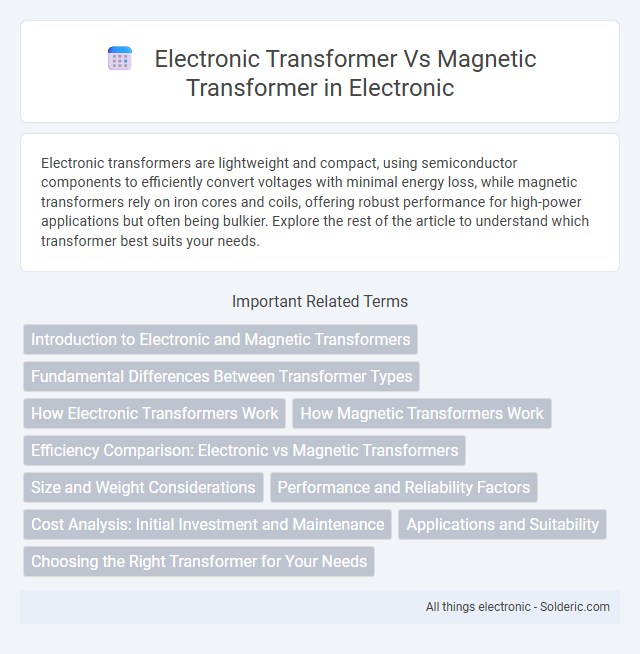Electronic transformers are lightweight and compact, using semiconductor components to efficiently convert voltages with minimal energy loss, while magnetic transformers rely on iron cores and coils, offering robust performance for high-power applications but often being bulkier. Explore the rest of the article to understand which transformer best suits your needs.
Comparison Table
| Feature | Electronic Transformer | Magnetic Transformer |
|---|---|---|
| Operating Principle | Converts voltage using electronic circuits and switching technology | Uses electromagnetic induction between coils to transfer voltage |
| Size & Weight | Compact and lightweight | Bulky and heavy due to iron core and coils |
| Efficiency | High efficiency at specified frequency ranges | Efficiency dependent on core material and lamination |
| Frequency | Operates at high frequencies (typically 20kHz to 60kHz) | Operates at standard power line frequency (50Hz/60Hz) |
| Output Stability | Stable output voltage with electronic regulation | Output voltage varies with load and input fluctuations |
| Applications | Low voltage lighting, LED drivers, compact power supplies | Power distribution, isolation, voltage conversion in AC mains |
| Cost | Generally higher due to complexity | Lower manufacturing cost |
| Durability & Maintenance | Sensitive to environmental factors; may require maintenance | Robust with minimal maintenance |
Introduction to Electronic and Magnetic Transformers
Electronic transformers utilize semiconductor components to convert voltage levels efficiently with minimal energy loss, making them ideal for compact and lightweight applications. Magnetic transformers rely on electromagnetic induction between coils wound around a ferromagnetic core to transfer power, providing robust performance in high-power and industrial settings. Understanding these differences helps you select the appropriate transformer type based on efficiency, size, and application needs.
Fundamental Differences Between Transformer Types
Electronic transformers operate using semiconductor components and high-frequency signals to convert voltage efficiently in compact designs, while magnetic transformers rely on electromagnetic induction between coils wrapped around a magnetic core. Electronic transformers offer lightweight, low-loss performance with better regulation but are limited in power capacity and sensitive to thermal conditions. Magnetic transformers provide robust, high-power handling with predictable thermal behavior but are bulkier and less energy-efficient due to core and copper losses.
How Electronic Transformers Work
Electronic transformers operate by converting electrical energy through high-frequency switching circuits that rapidly turn the input voltage on and off, inducing a magnetic field in a ferrite core. This process allows for a smaller, lighter design compared to traditional magnetic transformers, which rely on low-frequency alternating current passing through copper windings around an iron core. High-frequency operation enables electronic transformers to efficiently step up or step down voltage with minimal energy loss in applications such as LED lighting and compact power supplies.
How Magnetic Transformers Work
Magnetic transformers operate by transferring electrical energy between two or more coils through electromagnetic induction, utilizing a ferromagnetic core to concentrate the magnetic flux and increase efficiency. The primary coil generates a magnetic field that induces a voltage in the secondary coil according to Faraday's law of induction, enabling voltage step-up or step-down. Their robust design and ability to handle high power levels make magnetic transformers essential in power distribution and industrial applications.
Efficiency Comparison: Electronic vs Magnetic Transformers
Electronic transformers typically offer higher efficiency than magnetic transformers due to reduced core losses and lighter weight, making them ideal for energy-saving applications. Magnetic transformers rely on electromagnetic induction with iron cores, resulting in increased energy loss through heat and lower overall efficiency, especially at higher frequencies. For your projects, choosing an electronic transformer can significantly minimize energy consumption and improve performance in compact, modern devices.
Size and Weight Considerations
Electronic transformers are significantly smaller and lighter than magnetic transformers due to their use of high-frequency switching technology, which allows for a compact design with fewer bulky components. Magnetic transformers rely on large iron cores and copper windings, making them heavier and bulkier, especially at higher power ratings. The reduced size and weight of electronic transformers make them ideal for applications with space constraints and portability requirements.
Performance and Reliability Factors
Electronic transformers offer higher efficiency and more stable voltage regulation compared to magnetic transformers, due to advanced semiconductor components. Magnetic transformers are known for robust construction and long-term reliability in high-power applications, but they can experience energy loss from core heating and magnetic hysteresis. Your choice depends on performance needs; electronic models excel in lightweight, low-voltage scenarios, while magnetic transformers suit heavy-duty environments requiring durability.
Cost Analysis: Initial Investment and Maintenance
Electronic transformers generally have a higher initial investment compared to magnetic transformers due to advanced semiconductor components and compact designs, but they offer lower maintenance costs because of fewer mechanical parts and greater energy efficiency. Magnetic transformers, while cheaper upfront, require regular maintenance and are prone to wear and energy losses resulting in higher long-term expenses. Assessing your specific application needs can help optimize cost-effectiveness between these transformer types.
Applications and Suitability
Electronic transformers excel in low-power applications such as LED lighting, compact fluorescent lamps, and electronic devices due to their lightweight, compact size, and high-frequency operation. Magnetic transformers are better suited for high-power industrial applications, power distribution, and isolation purposes because of their robustness and ability to handle high voltages and currents efficiently. Electronic transformers offer enhanced energy efficiency and reduced electromagnetic interference, while magnetic transformers provide superior durability and reliability in harsh environments.
Choosing the Right Transformer for Your Needs
Electronic transformers offer compact size, higher efficiency, and lightweight design ideal for low-voltage lighting and electronic devices, while magnetic transformers provide robust performance, durability, and better heat dissipation suited for high-power industrial applications. Selecting the right transformer depends on factors such as voltage requirements, load type, energy efficiency needs, and application environment. For precise voltage regulation and energy-saving benefits in residential or commercial settings, electronic transformers are preferable; for heavy-duty tasks and long service life, magnetic transformers are more suitable.
electronic transformer vs magnetic transformer Infographic

 solderic.com
solderic.com